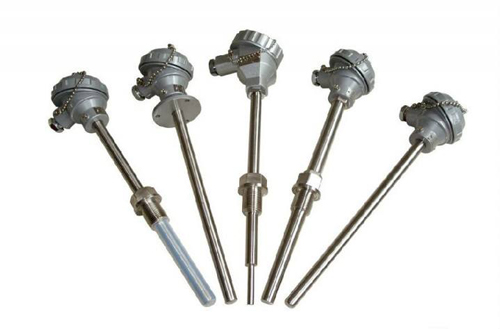RTD vs. Thermocouple
Industrial thermocouple and RTD protective casing are almost the same. Some temperature measuring elements are small in size, such as the armored type, and they also have similar shape. So, how to identify whether it is RTD sensor or thermocouple without nameplate or unknowing the type? The following methods are listed to figure out the RTD sensor and thermocouple for your reference.
Firstly, check the leading-out wires of the temperature measuring elements. Generally, the thermocouple has two leading-out wires while the RTD sensor has three wires.
However, if there are four leading-out lines, the resistance value shall be tested to judge if it’s a dual thermocouple or a four-wire thermal resistance/RTD sensor. Find out two pairs of leading-out lines from the four lines whose resistance value shall be zero, and then measure the resistance value between the two pairs of leading-out lines. If the value is infinite, it will be a dual thermocouple; the other with a zero resistance value shall be RTD sensor. If the measured resistance value is between 10 and 110, it’s a four-wire RTD/thermal resistance. Then compare its resistance value with standard, its graduation can be determined.
If there are only two leading-out lines, they can be identified with a digital multimeter. The resistance of the thermocouple is quite small while the RTD sensor is about zero. Therefore, if the measured resistance is small, it may be a thermocouple.
Besides, the RTD sensor’s minimum resistance value is larger than 10 at room temperature. The common RTD sensors include four graduations, namely Pt10 and Pt100 platinum thermal resistance, Cu50 and Cu100 copper thermal resistance. Under a room temperature of 20℃, their resistance values are as follows: Pt10 is 10.779, Pt100 is 107.794, Cu50 is 54.285 and Cu100 is 108.571. When the room temperature is higher than 20℃, RTD’s resistance values are larger. Then, the RTD and thermocouple can be mostly distinguished from resistance value. If it’s a RTD, its graduation can be further known.
The temperature sensors, RTD and thermocouple, can also be identified by heating with an accessible heat source. If you can get a cup of hot water, put the measuring tip of a temperature measuring element into the hot water and measure its thermoelectric potential with digital multimeter, the one with a thermoelectric potential is the thermocouple, its graduation can be obtained by looking up the thermocouple graduation table. If there’s no thermoelectric potential, measure if the resistance value changes, the one whose resistance value rises is the thermocouple. They can also be identified by heating the measuring tip with an electric iron or electric dry oven.
ATO.com provides you high accurate and fast response temperature sensors, including thermocouple with sheath or assembly (S type, K type, E type, B type, J type, T type, N type and R type) , and RTD sensors with 2 wire and 3 wire, etc.

